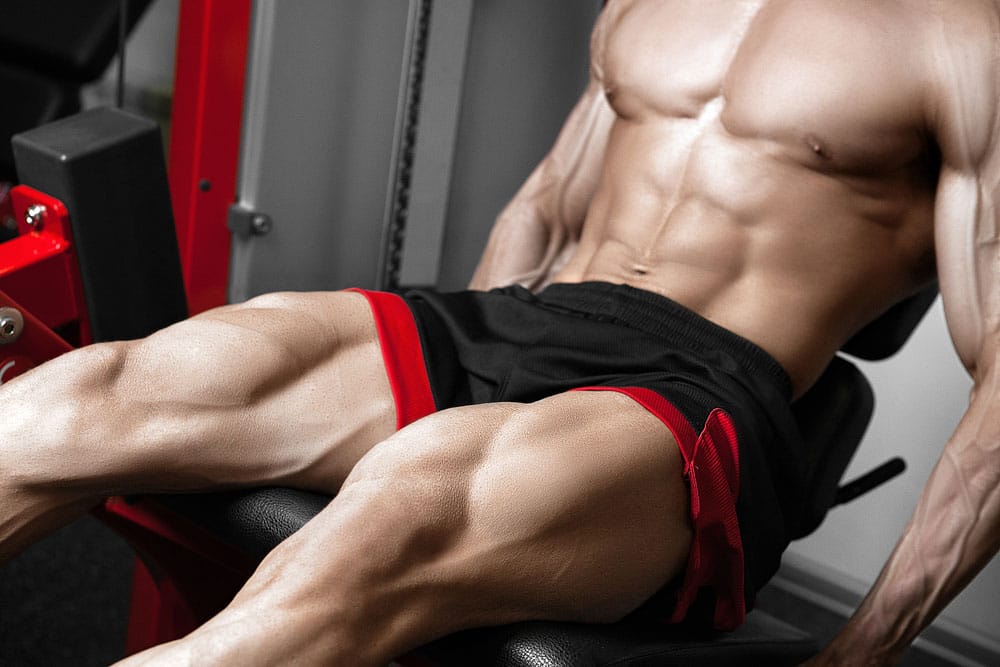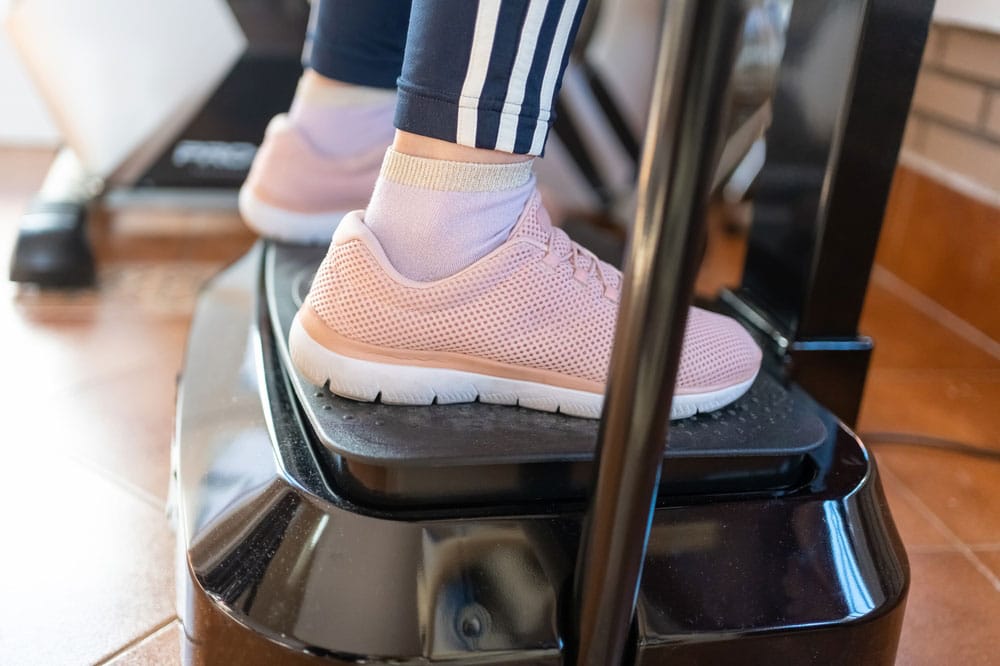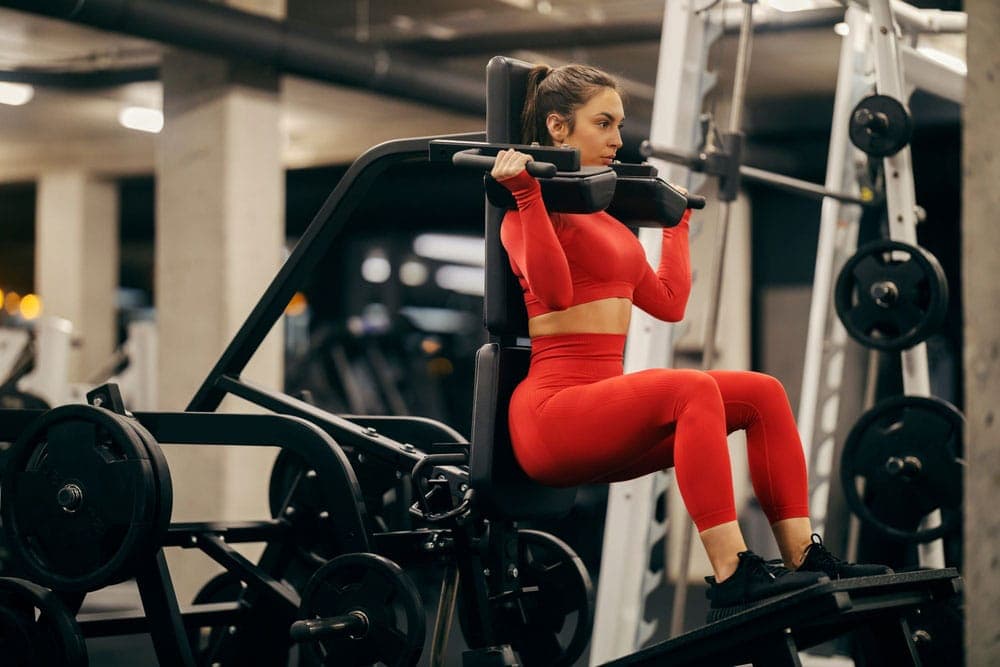Hack Squat Foot Placement: 5 Variations
This guide to hack squat foot placements will help you understand how to hack squat for growth. Learn the top 5 foot placements and which muscles they emphasize
If you want to get strong and see major leg growth, you need to be doing hack squats.
This move is one of the best ways to isolate your quadriceps muscles for stronger-looking legs. Here, we’ll take a look at 5 different hack squat foot placements.
Understand which muscles work harder in which foot placement and what you can do to grow your legs with hack squats.
What is the Hack Squat?
Hack squats are a cross between the V-squat machine— an upright assisted squat machine, and a seated leg press.
Usually, hack squat machines have a 45-degree position. This angle makes it simpler to place your feet on the footplate comfortably. Depending on which stance you use, it can also take the strain out of your knee joints.
This is a simple leg workout machine to use, whether you’re a beginner or an advanced gymgoer.
It’s not called a “hack squat” due to being a way to “hack” your leg day.
Old school wrestler and professional strongman George Hackenschmidt is its namesake. Hence, the “hack.”
This athlete was nicknamed the “Russian Lion.” Hackenshmidt was famous for pioneering the “bear hug” move that we see wrestlers use in competitive wrestling. He’s also known for pioneering the bench press.
Although it’s traditionally done with a hack squat machine, hack squatting is versatile. With a little innovation, you can do barbell hack squats or even Smith machine hack squats.
Let’s take a look at the leg muscles you work with hack squats.
Hack Squat— Muscles Worked
What makes a hack squat different than a barbell squat?
Hack squats target your quadriceps femoris muscles more directly. Although they do work the other muscles in your legs, the hack squat is a great way to train if you’re hoping to isolate your quads.

During hack squats, the working muscles include:
Quadriceps
Your quadriceps femoris muscles (“quads”) flex the knees. To get to the bottom of your hack squats, you’ll need a deep bend in the knees to help your body descend. Engaging your quadriceps will help you get there, so it’s important to strengthen your quads.
Hamstrings
These muscles live on the backs of your thighs. Hamstrings extend your hips at the top of a squat. They also help with knee flexion when you descend. This makes hamstrings an integral part of your squat. There are 3 hamstring muscles:
- Semitendinosus.
- Semimembranosus.
- Biceps femoris (this muscle has a long and short head).
Always stretch your hamstrings after you squat. It’s a good idea to warm them up too.
Active warm-ups, like high knees, leg swings, or folding your body forward will help get your hamstrings ready for healthy hack squats.
Most of us have tight hamstrings since we don’t move them. Our increasingly sedentary lifestyles don’t let us get as much hamstring mobility as we should. The effect of hamstring tightness includes reduced stability and agility.
Because the hamstrings serve a double purpose of hip extension and knee flexion, they’re extra susceptible to injuries. You can read more here: The mechanism of hamstring injuries.
Glutes
The gluteal muscles help keep the pace of your squats as you drop down and come back up. This muscle group (your butt!) is made up of three muscles: the gluteus maximus, gluteus medius and gluteus minimus.
Hack squats are some of the best exercises for a round butt. Make sure to squeeze your glutes as you come up to the top to give your glutes a burn.
Calves
The calves stabilize your legs. They connect you to your feet to stay grounded. The calf is made up of the soleus muscle and the gastrocnemius. These muscles help you to plantarflex your foot (point your toes downward).
From the bottom of your squat, your calves will engage to help you drive up through the heels and feet to bring yourself back up to a standing position. When you use a low hack squat foot placement, you can put some serious impact on your calves.
Benefits of Hack Squats
Toned Legs
Because they are made to hit your quads specifically, hack squats can be a serious strength-builder for these lower leg muscles. Of course, depending on which hack squat foot placement you use, you can focus on other muscles too.
If you’re training for aesthetics, the leg muscles look seriously sexy when they’re well-developed. Women and men can both benefit from toned legs. On the female body, strong calves can look great and give you the look of wider hips.
Less Back Pain
Hack squat helps you reduce the lower back intensity you’d get from a traditional squat.
Back pain is one common reason people look for emergency medical care. In fact, evidence suggests that back pain management accounts for about $200 billion in medical costs per year.
If you’re prone to back pain, hack squats can be a safer option. They let you take strain out of your squats so your low back is protected.
Safety
Most commercial hack squat machines have safety bars that keep the machine from moving when you’re not using it.
If you find barbells intimidating, the hack squat’s advanced safety features may put your mind at ease.
How to Use Hack Squat Machines
To start:
- Set-Up: Load up your machine with a comfortable squat weight. If you’re used to barbell squatting, you might be able to lift more weight than you think with a hack squat. You want to challenge yourself but don’t go too heavy or you may tire out fast.
- Body Position: Step onto the platform of your hack squat machine. Place your back up against the backplate and your shoulders under the shoulder pads. Stand with your feet hip-width apart (standard placement). Turn your toes out slightly. Grab the side grip handles for support.
- Squat: Slowly bend your knees to let the backplate move down on the machine. Keep your back straight and planted against the back pad. Continue until the angle between your thighs and calves is at 90 degrees or slightly deeper.
- Reverse: Exhale to drive your feet into the footplate and reverse your movement. Push through your heels and straighten your legs to come back to your starting position.
- Reps: For strength, try 5 sets of 4-6 reps with a heavy weight. If you are training for hypertrophy, aim for 4 sets of 6-8 reps with a moderately heavy weight.
Hack Squat Foot Placements
Standard
For standard foot placement on your hack squat machine, place your feet shoulder-width apart in the middle of your footplate.
This foot placement is best if you’re a beginner just getting to know the hack squat machine or if you don’t have a set training goal other than well-rounded leg growth.
This stance helps you put equal emphasis on all your leg muscles.
The one downside to this placement is that it doesn’t let you flex as deeply as other positions. If you’re looking to grow huge quads, there may be more optimal placements for you.

High
A higher placement emphasizes your hamstrings. This hack squat foot placement will make the backs of your legs sing!
That being said, high foot placement doesn’t allow you to extend your hips as well. Because of this, you’ll feet this one less strongly in your glutes. If you are looking to build a heart-shaped butt or shelf butt, you’ll probably want a stance that lets you do more butt-dominant work.
Low
This placement lets you work the glutes, calves and quads primarily. You can even elevate your heels for a Tom Platz hack squat variation.
In a low foot placement hack squat, expect your knees to extend far over your toes. This will bring you into deep knee flexion, so be careful here if you have knee injuries.
Wide
This stance is better for getting low. Wide stances are a great way to improve your hack squat depth. This foot placement hits the inside muscles of your thighs— the hip adductors.
Wide stances also allow for more recruitment of the glutes in your squats.
Narrow
If you want to improve your butt shape, this one’s for you! Narrow foot placement is a great way to grow your glutes. This variation mostly hits your hip abductors. There are the muscles on the outside of your thighs.
These muscles help you pull your thighs outward from the midline of your body. Strong outer thighs are essential for the basic movement of your legs.
Your hip adductor and abductor muscle activation are also associated with functional performance.
Hack Squat Tips and Tricks
Keep Your Back Planted.
The hack squat already puts your torso in an upright position. This mimics the form that you would use in a barbell squat. It can help you build your form if you want to get out from under the machine and work out with free weights.
Letting your torso come off the backrest destroys the benefits a hack squat can have for your posture. Keep things in place with your back firmly planted and you help make your lifts easier.
Understand the Safety Bars
Most hack squats have safety levers, bars or handles that you pull either inward or outward to unlock. Get to know your machine before you squat. It may take some trial and error to make sure that it is properly unlocked and safe to use.
Final Word
If you’re training for hypertrophy adding hack squats to your routine is a great way to get bigger legs. You isolate your quads more sharply in a hack squat, vs. barbell squat.
Your quads, glutes, and hamstrings tend to work evenly to keep you stable in standard hack squat foot placement.
Wide stances work the adductors and glutes, narrow stances focus on the hip abductors— the outer thighs. A low stance lets you get deeper knee flexion and work your quads, sending the toes out over your knees. And high feet are great for developing the hamstrings.
Play around with the different hack squat foot positions and see which ones you like best. If you like to stay seated or are feeling a little lazy to work out, try these foot placements on the leg press instead for a slightly more low-key leg day.
References
Encarnación-Martínez, A., García-Gallart, A., Pérez-Soriano, P., Catalá-Vilaplana, I., Rizo-Albero, J., & Sanchis-Sanchis, R. (2023). Effect of Hamstring Tightness and Fatigue on Dynamic Stability and Agility in Physically Active Young Men. Sensors (Basel, Switzerland), 23(3), 1633. https://doi.org/10.3390/s23031633
Casiano VE, Sarwan G, Dydyk AM, et al. Back Pain. [Updated 2023 Dec 11]. In: StatPearls [Internet]. Treasure Island (FL): StatPearls Publishing; 2024 Jan-. Available from: https://www.ncbi.nlm.nih.gov/books/NBK538173/
Danielsson, A., Horvath, A., Senorski, C., Alentorn-Geli, E., Garrett, W. E., Cugat, R., Samuelsson, K., & Hamrin Senorski, E. (2020). The mechanism of hamstring injuries - a systematic review. BMC musculoskeletal disorders, 21(1), 641. https://doi.org/10.1186/s12891-020-03658-8
Lanza, M. B., Rock, K., Marchese, V., Addison, O., & Gray, V. L. (2021). Hip Abductor and Adductor Rate of Torque Development and Muscle Activation, but Not Muscle Size, Are Associated With Functional Performance. Frontiers in physiology, 12, 744153. https://doi.org/10.3389/fphys.2021.744153
Myer, G. D., Kushner, A. M., Brent, J. L., Schoenfeld, B. J., Hugentobler, J., Lloyd, R. S., Vermeil, A., Chu, D. A., Harbin, J., & McGill, S. M. (2014). The back squat: A proposed assessment of functional deficits and technical factors that limit performance. Strength and conditioning journal, 36(6), 4–27. https://doi.org/10.1519/SSC.0000000000000103
Nicolini, A. P., de Carvalho, R. T., Matsuda, M. M., Sayum, J. F., & Cohen, M. (2014). Common injuries in athletes' knee: experience of a specialized center. Acta ortopedica brasileira, 22(3), 127–131. https://doi.org/10.1590/1413-78522014220300475
Related articles


Get fit with Flex
Build muscle & lose weight fast for free.
Available on iPhone + Apple Watch





